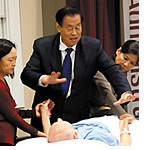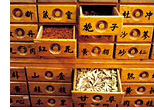
Not a subscriber?
Unsubscribe
Update e-mail address
February 2012 [Volume 11, Issue 2]
To Your Health is brought to you by:
In this issue of To Your Health:
- Dr. Shi Xue-Min and the Xing Nao Kai Qiao Legacy
- Herb of the Month – Oldenlandia (bai hua she she cao)
- Ask an Acupuncturist
Dr. Shi Xue-Min and the Xing Nao Kai Qiao Legacy
By Jing Liu, OMD, LAc, PhD and Kun Liu, LAc
 To the acupuncture community, Dr. Shi Xue-Min is known as a distinguished acupuncturist and academician of the Chinese Academy of Engineering and a supervisor of doctoral candidates in China. Dr. Shi Xue-Min is particularly known for his creation of the stroke acupuncture technique Xing Nao Kai Qiao (XNKQ), which is translated as "activating the brain and opening the orifices." During the Chinese Revolution, he was among a few who survived in his position. After establishing The First Teaching Hospital University of Traditional Chinese Medicine in Tianjin, China, Dr. Shi's leadership allowed the hospital to grow to an astounding degree, from 200 beds to 2,000 beds.
To the acupuncture community, Dr. Shi Xue-Min is known as a distinguished acupuncturist and academician of the Chinese Academy of Engineering and a supervisor of doctoral candidates in China. Dr. Shi Xue-Min is particularly known for his creation of the stroke acupuncture technique Xing Nao Kai Qiao (XNKQ), which is translated as "activating the brain and opening the orifices." During the Chinese Revolution, he was among a few who survived in his position. After establishing The First Teaching Hospital University of Traditional Chinese Medicine in Tianjin, China, Dr. Shi's leadership allowed the hospital to grow to an astounding degree, from 200 beds to 2,000 beds.
Dr. Shi has nearly 50 years of experience in the field of Traditional Chinese Medicine. He is the recipient of numerous awards and has published extensively. He has been the past recipient of 15 awards and two patents on the state, ministerial and municipal levels. He also published 12 major works, more than 30 theses, and authored more than 40 books. The work he has done has greatly encouraged many doctors to conduct research on the effects of acupuncture and meridians.
Herb of the Month – Oldenlandia (bai hua she she cao)
 What is oldenlandia? What is it used for?
What is oldenlandia? What is it used for?
Oldenlandia is one of the oldest herbs in traditional Chinese medicine, and has one of the longest Chinese herb names. It grows mainly in the southeastern provinces of China, and is found it low altitudes in fields with moist soil.
It gets its name due in part to its leaves, which are thin and are shaped like a snake's tongue. The part of the plant used in herbal formulas is the rhizome. It is collected in summer and autumn, with the fibrous roots removed, before being used fresh or dried.
In traditional Chinese medicine, oldenlandia has slightly bitter, sweet and cold properties. Its functions are to clear heat, resolve toxins, and relieve swellings on the skin. Oldenlandia can be used internally or externally. Its most famous use is to treat snake bites, particularly the bite of the agkistrodon, a type of pit viper. Oldenlandia has also been employed to treat sores and carbuncles on the skin, appendicitis, sore throats, and urinary tract infections. Experiments conducted in China suggest that an oldenlandia extract can also treat some types of cancer in animals; however, these studies have yet to be duplicated in humans.
How much oldenlandia should I take?
The amount of oldenlandia to be taken depends on the condition being treated. To treat skin problems and acne, 20 to 30 grams of oldenlandia can be combined with other herbs and boiled in water, then applied to the skin as a type of wash. Larger doses (extracts of 30-60 grams) have been used in clinical studies to help treat some forms of cancer. Oldenlandia is often used with other herbs, such as scutellaria, as a decoction. Typically, it is recommended that patients take small amounts of oldenlandia first, gradually raising the dosage to an acceptable level.
What forms of oldenlandia are available?
Fresh oldenlandia can be found at many Asian markets and specialty stores. Oldenlandia is also available in pill, powder, extract and infusion form. Fresh oldenlandia can also be harvested and crushed to create oldenlandia juice.
What can happen if I take too much oldenlandia? Are there any interactions I should be aware of? What precautions should I take?
Oldenlandia should not be taken by pregnant women. In addition, it may cause allergic skin reactions in some individuals; if this occurs, patients should discontinue use. As always, make sure to consult with a licensed health care provider before taking oldenlandia or any other herbal remedy or dietary supplement.
Question about TMJ: I am being treated for TMJ I developed about a month or so after having dental work done last year. I'm now wearing a mouth guard 24/7, eating soft foods, taking large doses of Ibuprofen and muscle relaxants--nothing is helping. Can acupuncture help end the misalignment/clicking in the jaw?
Answer: I have treated many cases successfully. You need to have an examination for an evaluation of your individual symptoms. Not everyone can be improved but most can. It is worth a try (10 or so treatments) because ibuprofen for a long time is not good for your digestive system.
Unsubscribe
Thank you for subscribing to To Your Health. If you have received
this newsletter in error or wish to unsubscribe, you may remove your name
from our e-mail subscription list at www.acupuncturetoday.com/newsletter/TYH/unsubscribe.php.
Update your e-mail address
To update the e-mail address your newsletter is sent to, click here.
If you have any questions regarding your subscription, please complete this form at www.acupuncturetoday.com/newsletterhelp/TYH.
